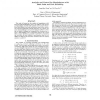Free Online Productivity Tools
i2Speak
i2Symbol
i2OCR
iTex2Img
iWeb2Print
iWeb2Shot
i2Type
iPdf2Split
iPdf2Merge
i2Bopomofo
i2Arabic
i2Style
i2Image
i2PDF
iLatex2Rtf
Sci2ools
82
Voted
ICRA
1993
IEEE
1993
IEEE
Analysis and Control for Manipulators with Both Joint and Link Flexibility
This work is focused on the analysis of manipulators with both joint and link flexibility. Due to the different order of joint and link stiffness, the full-order nonlinear system can be decomposed into different time-scale subsystems, namely, slow subsystem, mid-speed subsystem, and fast subsystem. It is shown that when the link stiffness is much greater than joint stiffness 01- when the two kinds of stiffness are comparable the vibrations due to joint or link flexibility can be suppressed whatever the control effort is made. Therefore, a composite control law is proposed in the case where the joint stiffness is much greater than the link stiffness to eliminate the structural vibrations while the tracking objective is achieved.
ICRA 1993 | Joint | Joint Stiffness | Link Stiffness | Robotics |
Related Content
| Added | 08 Aug 2010 |
| Updated | 08 Aug 2010 |
| Type | Conference |
| Year | 1993 |
| Where | ICRA |
| Authors | Jung-Hua Yang, Li-Chen Fu |
Comments (0)

